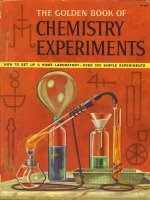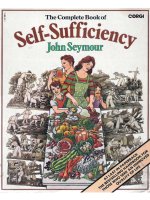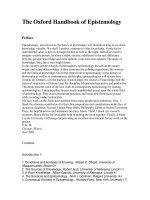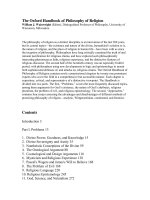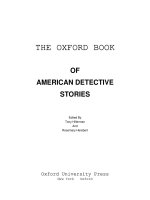- Trang chủ >>
- Khoa Học Tự Nhiên >>
- Vật lý
the oxford book of modern science writing jun 2008
Bạn đang xem bản rút gọn của tài liệu. Xem và tải ngay bản đầy đủ của tài liệu tại đây (5.62 MB, 438 trang )
The Oxford Book of
MODERN SCIENCE WRITING
This page intentionally left blank
The Oxford Book of
MODERN
SCIENCE
WRITING
RICHARD DAWKINS
1
3
Great Clarendon Street, Oxford ox26dp
Oxford University Press is a department of the University of Oxford.
It furthers the University’s objective of excellence in research, scholarship,
and education by publishing worldwide in
Oxford New York
Auckland Cape Town Dar es Salaam Hong Kong Karachi
Kuala Lumpur Madrid Melbourne Mexico City Nairobi
New Delhi Shanghai Taipei Toronto
With offi ces in
Argentina Austria Brazil Chile Czech Republic France Greece
Guatemala Hungary Italy Japan Poland Portugal Singapore
South Korea Switzerland Thailand Turkey Ukraine Vietnam
Oxford is a registered trade mark of Oxford University Press
in the UK and in certain other countries
Published in the United States
by Oxford University Press Inc., New York
Introduction, selection and commentary
© Richard Dawkins
2008
The moral rights of the author have been asserted
Database right Oxford University Press (maker)
First published
2008
All rights reserved. No part of this publication may be reproduced,
stored in a retrieval system, or transmitted, in any form or by any means,
without the prior permission in writing of Oxford University Press,
or as expressly permitted by law, or under terms agreed with the appropriate
reprographics rights organization. Enquiries concerning reproduction
outside the scope of the above should be sent to the Rights Department,
Oxford University Press, at the address above
You must not circulate this book in any other binding or cover
and you must impose the same condition on any acquirer
British Library Cataloguing in Publication Data
Data available
Library of Congress Cataloging in Publication Data
Data available
Typeset by SPI Publisher Services, Pondicherry, India
Printed in Great Britain
on acid-free paper by
Clays Ltd, St Ives plc
ISBN
978–0–19–921680–2
13579108642
For Charles Simonyi,
who loves science, loves language,
and understands how to put them together
This page intentionally left blank
CONTENTS
xi Featured Writers and Extracts
xvii Introduction
PART I
What Scientists Study
3 James Jeans from THE MYSTERIOUS UNIVERSE
4 Martin Rees from JUST SIX NUMBERS
11 Peter Atkins from CREATION REVISITED
16 Helena Cronin from THE ANT AND THE PEACOCK
18 R. A. Fisher from THE GENETICAL THEORY OF NATURAL SELECTION
22 Theodosius Dobzhansky from MANKIND EVOLVING
27 G. C. Williams from ADAPTATION AND NATURAL SELECTION
30 Francis Crick from LIFE ITSELF
35 Matt Ridley from GENOME
40 Sydney Brenner ‘THEORETICAL BIOLOGY IN THE THIRD
MILLENNIUM’
48 Steve Jones from THE LANGUAGE OF THE GENES
53 J. B. S. Haldane from ‘ON BEING THE RIGHT SIZE’
59 Mark Ridley from THE EXPLANATION OF ORGANIC DIVERSITY
61 John Maynard Smith ‘THE IMPORTANCE OF THE NERVOUS
SYSTEM IN THE EVOLUTION OF ANIMAL FLIGHT’
66 Fred Hoyle from MAN IN THE UNIVERSE
69 D’Arcy Thompson from ON GROWTH AND FORM
78 G. G. Simpson from THE MEANING OF EVOLUTION
82 Richard Fortey from TRILOBITE!
86 Colin Blakemore from THE MIND MACHINE
89 Richard Gregory from MIRRORS IN MIND
96 Nicholas Humphrey ‘ONE SELF: A MEDITATION ON THE UNITY OF
CONSCIOUSNESS’
103 Steven Pinker from THE LANGUAGE INSTINCT and HOW THE
MIND WORKS
viii
.
CONTENTS
110 Jared Diamond from THE RISE AND FALL OF THE THIRD
CHIMPANZEE
114 David Lack from THE LIFE OF THE ROBIN
115 Niko Tinbergen from CURIOUS NATURALISTS
123 Robert Trivers from SOCIAL EVOLUTION
127 Alister Hardy from THE OPEN SEA
130 Rachel Carson from THE SEA AROUND US
138 Loren Eiseley from ‘HOW FLOWERS CHANGED THE WORLD’
143 Edward O. Wilson from THE DIVERSITY OF LIFE
PART II
Who Scientists Are
151 Arthur Eddington from THE EXPANDING UNIVERSE
152 C. P. Snow from the Foreword to G. H. Hardy’s A MATHEMATICIAN’S
APOLOGY
157 Freeman Dyson from DISTURBING THE UNIVERSE
161 J. Robert Oppenheimer from ‘WAR AND THE NATIONS’
168 Max F. Perutz ‘A PASSION FOR CRYSTALS’
172 Barbara and George Gamow ‘SAID RYLE TO HOYLE’
174 J. B. S. Haldane ‘CANCER’S A FUNNY THING’
176 Jacob Bronowski from THE IDENTITY OF MAN
179 Peter Medawar from ‘SCIENCE AND LITERATURE, ‘DARWIN’S
ILLNESS’, ‘THE PHENOMENON OF MAN’, the postscript to
‘LUCKY JIM’, and ‘D’ARCY THOMPSON AND GROWTH
AND FORM’
188 Jonathan Kingdon from SELF-MADE MAN
190 Richard Leakey and Roger Lewin from ORIGINS RECONSIDERED
195 Donald C. Johanson and Maitland A. Edey from LUCY
200 Stephen Jay Gould ‘WORM FOR A CENTURY, AND ALL SEASONS’
211 John Tyler Bonner from LIFE CYCLES
214 Oliver Sacks from UNCLE TUNGSTEN
219 Lewis Thomas ‘SEVEN WONDERS’
226 James Watson from AVOID BORING PEOPLE
229 Francis Crick from WHAT MAD PURSUIT
232 Lewis Wolpert from THE UNNATURAL NATURE OF SCIENCE
234 Julian Huxley from ESSAYS OF A BIOLOGIST
235 Albert Einstein ‘RELIGION AND SCIENCE’
239 Carl Sagan from THE DEMON-HAUNTED WORLD
PART III
What Scientists Think
247 Richard Feynman from THE CHARACTER OF PHYSICAL LAW
249 Erwin Schrödinger from WHAT IS LIFE?
254 Daniel Dennett from DARWIN’S DANGEROUS IDEA and
CONSCIOUSNESS EXPLAINED
259 Ernst Mayr from THE GROWTH OF BIOLOGICAL THOUGHT
263 Garrett Hardin from ‘THE TRAGEDY OF THE COMMONS’
266 W. D. Hamilton from GEOMETRY FOR THE SELFISH HERD and
NARROW ROADS OF GENELAND
273 Per Bak from HOW NATURE WORKS
276 Martin Gardner THE FANTASTIC COMBINATIONS OF JOHN
CONWAY’S NEW SOLITAIRE GAME ‘LIFE’
284 Lancelot Hogben from MATHEMATICS FOR THE MILLION
289 Ian Stewart from THE MIRACULOUS JAR
297 Claude E. Shannon and Warren Weaver from THE MATHEMATICAL
THEORY OF COMMUNICATION
305 Alan Turing from COMPUTING MACHINERY AND
INTELLIGENCE
314 Albert Einstein from ‘WHAT IS THE THEORY OF RELATIVITY?’
317 George Gamow from MR TOMPKINS
323 Paul Davies from THE GOLDILOCKS ENIGMA
332 Russell Stannard from THE TIME AND SPACE OF UNCLE ALBERT
336 Brian Greene from THE ELEGANT UNIVERSE
342 Stephen Hawking from A BRIEF HISTORY OF TIME
PART IV
What Scientists Delight In
349 S. Chandrasekhar from TRUTH AND BEAUTY
352 G. H. Hardy from A MATHEMATICIAN’S APOLOGY
357 Steven Weinberg from DREAMS OF A FINAL THEORY
CONTENTS
.
ix
x
.
CONTENTS
362 Lee Smolin from THE LIFE OF THE COSMOS
367 Roger Penrose from THE EMPEROR’S NEW MIND
371 Douglas Hofstadter from GÖDEL, ESCHER, BACH: THE ETERNAL
GOLDEN BRAID
378 John Archibald Wheeler with Kenneth Ford from GEONS, BLACK
HOLES, AND QUANTUM FOAM
381 David Deutsch from THE FABRIC OF REALITY
383 Primo Levi from THE PERIODIC TABLE
390 Richard Fortey from LIFE: AN UNAUTHORIZED BIOGRAPHY
392 George Gaylord Simpson from THE MEANING OF EVOLUTION
393 Loren Eiseley from LITTLE MEN AND FLYING SAUCERS
394 Carl Sagan from PALE BLUE DOT
397 Acknowledgements
401 Index
FEATURED WRITERS AND EXTRACTS
Atkins, Peter (1940– ) Chemist and writer. Extract from Creation Revisited,
Penguin, 1994.
Bak, Per (1948–2002) Theoretical physicist. How Nature Works, OUP, 1997.
Blakemore, Colin (1944– ) Neurobiologist. Sight Unseen, BBC books, 1988.
Bonner, John Tyler (1920– ) Biologist. Life Cycles: Refl ections of an Evolutionary
Biologist, Princeton University Press, 1993.
Brenner, Sydney (1927– ) Biologist and Nobel laureate. ‘Theoretical Biology in
the Third Millennium’, Phil. Trans. R. Soc. Lond. B, 354, 1963–1965, 1999.
Bronowski, Jacob (1908–1974) Mathematician and broadcaster. The Identity of
Man, Prometheus, 2002. First published 1965.
Carson, Rachel (1907–1964) Marine biologist and natural history writer. The Sea
Around Us, OUP, 1989. First published 1951.
Chandrasekhar, S. (1910–1995) Astrophysicist and Nobel laureate. Truth and
Beauty, University of Chicago Press, 1987.
Crick, Francis (1916–2004) Molecular biologist and Nobel laureate. What Mad
Pursuit, Basic Books Inc., 1988, and Life Itself, Macdonald and Co, 1981.
Cronin, Helena (1942– ) Philosopher of biology. The Ant and the Peacock,
Cambridge University Press, 1991.
Davies, Paul (1946– ) Cosmologist and science writer. The Goldilocks Enigma,
Allen Lane, 2006.
Dennett, Daniel C. (1942– ) Philosopher. Consciousness Explained, Penguin, 1993
and Darwin’s Dangerous Idea, Penguin, 1996.
Deutsch, David (1953– ) Physicist. Fabric of Reality, Penguin, 1997.
Diamond, Jared (1937– ) Evolutionary biologist, biogeographer and writer.
The Rise and Fall of the Third Chimpanzee, Vintage, 1992.
Dobzhansky, Theodosius (1900–1975) Geneticist and evolutionary biologist.
Mankind Evolving, Yale University Press, 1962.
Dyson, Freeman (1923– ) Physicist and mathematician. Disturbing the Universe,
Pan Books, 1981.
Eddington, Sir Arthur (1882–1944) Astrophysicist. The Expanding Universe,
Cambridge Penguin, 1940.
Edey, Maitland A. (1910–1992) Science writer and conservationist. Donald
C. Johanson and Maitland A. Edey, Lucy: The Beginnings of Humankind,
Penguin, 1990. First published 1981.
Einstein, Albert (1879–1955) Theoretical physicist and Nobel laureate. Reprinted
in Ideas and Opinions, Wings Books, 1954. ‘What is the theory of relativity?’
published in The London Times, 1919. ‘Religion and Science’ published in the
New York Times Magazine, 1930.
Eiseley, Loren (1907–1977) Anthropologist, ecologist and writer. ‘How Flow-
ers Changed the World’ and ‘Little Men and Flying Saucers’, in The Immense
Journey, Vintage, 1957.
Feynman, Richard P. (1918–1988) Theoretical physicist and Nobel laureate.
The Character of Physical Law, Penguin, 1992.
Fisher, Sir Ronald (1890–1962) Statistician, evolutionary biologist and geneticist.
The Genetical Theory of Natural Selection, OUP, 2006.
Ford, Kenneth (1926– ) Physicist. John Archibald Wheeler and Kenneth Ford,
Geons, Black Holes and Quantum Foam: a life in physics, WW Norton, 1998.
Fortey, Richard (1946– ) Palaeontologist. Trilobite!, Flamingo, 2001. Originally
published 2000. Life: an Unauthorised Biography, Flamingo, 1998.
Gamow, George (1904–1968) Theoretical physicist and cosmologist. Mr Tompkins
in Paperback, Cambridge University Press, 1993. Mr Tomkins in Wonderland fi rst
published 1940.
Gardner, Martin (1914– ) Mathematics and Science Writer. ‘Mathematical
Games’ column, Scientifi c American 223, October 1970.
Gould, Stephen Jay (1941–2002) Palaeontologist, evolutionary biologist and
writer. ‘Worm for a Century and All Seasons’, in Hen’s Teeth and Horse’s Toes,
W W Norton & Co., 1983.
Greene, Brian (1963– ) Theoretical Physicist. The Elegant Universe, Vintage, 2000.
Gregory, Richard (1923– ) Neuropsychologist. Mirrors in Mind, W. H. Freeman
& Co. Ltd, 1997.
Haldane, J. B. S. (1892–1964) Geneticist and evolutionary biologist. On Being the
Right Size and Other Essays, Oxford University Press, 1991, formerly published
in Possible Worlds and Other Essays, Chatto & Windus, 1927. ‘Cancer’s a Funny
Thing’, New Statesman, 1964.
Hamilton, W. D. (1936–2000) Evolutionary biologist. ‘Geometry for the Selfi sh
Herd’, Journal of Theoretical Biology, 31, 295–311, reprinted in Narrow Roads of
Gene Land, Vol. 1. W. H. Freeman, 1996.
xii
.
FEATURED WRITERS AND EXTRACTS
Hardin, Garrett (1915–2003) Ecologist. ‘The Tragedy of the Commons’, Science,
162, No. 3859, 1243–48, 1968.
Hardy, Alister (1896–1985) Marine biologist. The Open Sea: Its Natural History,
Part 1: The World of Plankton. Collins, 1970. First published 1956.
Hardy, G.H. (1877–1947) Mathematician. A Mathematician’s Apology, Cambridge
University Press, 2007. First published 1940.
Hawking, Stephen (1942– ) Theoretical physicist. A Brief History of Time, Bantam
Books, 1988.
Hofstadter, Douglas R. (1945– ) Cognitive scientist, philosopher, polymath,
Pulitzer Prize-winning author. Godel, Escher, Bach, Basic Books, 1979.
Hogben, Lancelot (1895–1975) Zoologist and statistician. Mathematics for the
Million, Norton, 1993. Originally published 1937.
Hoyle, Fred (1915–2001) Astronomer and writer. Man in the Universe, Columbia
University Press, 1966.
Humphrey, Nicholas (1943– ) Psychologist. ‘One Self’, in The Mind Made Flesh,
Oxford University Press, 2002. First published in Social Research, 67, 32–39, 2000.
Huxley, Julian (1887–1975) Evolutionary biologist. Essays of a Biologist, Chatto &
Windus, 1929. First published 1923.
Jeans, James (1877–1946) Physicist, astronomer and mathematician. The Mysterious
Universe, Cambridge University Press, 1930.
Johanson, Donald C. (1943– ) Palaeoanthropologist. Donald C. Johanson and
Maitland A. Edey, Lucy: The Beginnings of Humankind, Penguin, 1990.
Jones, Steve (1944– ) Geneticist and writer. The Language of Genes, Flamingo, 2000.
Kingdon, Jonathan (1935– ) Biologist, artist, and writer. Before the Wise Men,
Simon and Schuster, 1993.
Lack, David (1910–1973) Ornithologist. The Life of the Robin, Collins, 1965.
Leakey, Richard (1944– ) Palaeoanthropologist and conservationist. Richard
Leakey and Roger Lewin, Origins Reconsidered, Little, Brown, 1992.
Levi, Primo (1919–1987) Chemist and writer. The Periodic Table, Penguin Classics,
2000. This translation, by Raymond Rosenthal, fi rst published by Shocken Books,
1984.
Lewin, Roger Anthropologist and science writer. Richard Leakey and Roger
Lewin, Origins Reconsidered, Little, Brown, 1992.
Maynard Smith, John (1920–2004) Evolutionary biologist and geneticist. On
Evolution, Edinburgh University Press, 1972.
Mayr, Ernst (1904–2005) Evolutionary biologist. The Growth of Biological
Thought, Harvard University Press, 1982.
Medawar, Peter B. (1915–1987) Medical scientist and writer, Nobel laureate.
‘Science and Literature’ from The Hope of Progress, Wildwood House, 1974;
FEATURED WRITERS AND EXTRACTS
.
xiii
‘Darwin’s Illness’, ‘The Phenomenon of Man’, and the postscript to ‘Lucky Jim’
from The Strange Case of the Spotted Mice, Oxford University Press, 1996; ‘D’Arcy
Thompson and Growth and Form’ from The Art of the Soluble, Penguin, 1969.
Oppenheimer, J. Robert (1904–1967) Theoretical physicist. The Flying Trapeze:
three crisis for physicists, Oxford University Press, 1964.
Penrose, Roger (1931– ) Mathematical Physicist. The Emperor’s New Mind,
Oxford University Press, 1989.
Perutz, Max (1914–2002) Molecular biologist. ‘A Passion for Crystals’, in I Wish
I’d Made You Angry Earlier, Oxford University Press, 1998. First published as
an obituary in The Independent, 1994.
Pinker, Steven (1954– ) Psychologist, cognitive scientist and writer. How The
Mind Works, Allen Lane, 1997 and The Language Instinct, Allen Lane, 1994.
Rees, Martin (1942– ) Cosmologist and writer. Just Six Numbers, Phoenix, 2000.
Ridley, Mark (1956– ) Zoologist and science writer. The Explanation of Organic
Diversity, Clarendon Press, 1983.
Ridley, Matt (1958– ) Zoologist and science writer. Genome, Fourth Estate, 1999.
Sacks, Oliver (1933– ) Neurologist and writer. Uncle Tungsten, Picador, 2001.
Sagan, Carl (1934–1996) Astronomer and writer. Pale Blue Dot, Ballantine, 1997.
Schrodinger, Erwin (1887–1961) Physicist and Nobel laureate. What is Life?,
Cambridge University Press, 2000. First published 1944.
Shannon, Claude (1916–2001) Electrical engineer and mathematician. Claude
Shannon and Warren Weaver, The Mathematical Theory of Communication,
University of Illinois Press, 1980. Originally published 1949.
Simpson, George Gaylord (1902–1984) Palaeontologist. Meaning of Evolution,
Yale University Press, 1963. First published 1949.
Smolin, Lee (1955– ) Theoretical physicist. The Life of the Cosmos, Phoenix, 1997.
Snow, C.P. (1905–1980) Physicist and novelist. G.H. Hardy’s A Mathematician’s
Apology (Foreword), Cambridge University Press, 1967.
Stannard, Russell (1931– ) Physicist and writer. The Time and Space of Uncle
Albert, Faber and Faber, 1989.
Stewart, Ian (1945– ) Mathematician and writer. From Here to Infi nity, Oxford
University Press, 1996. First published as The Problems of Mathematics, 1987.
Thomas, Lewis (1913–1993) Physician and essayist. Late Night Thoughts, Oxford
University Press, 1985. First published 1980.
Thompson, D’Arcy Wentworth (1860–1948) Biologist and classicist. On Growth and
Form, Cambridge University Press, 2004. Original complete work published 1917.
Tinbergen, Niko (1907–1988) Ethologist, ornithologist and Nobel laureate. Curious
Naturalists, Country Life, 1958.
xiv
.
FEATURED WRITERS AND EXTRACTS
Trivers, Robert (1943– ) Evolutionary biologist. Social Evolution, Benjamin-
Cummings Publishing Co, 1985.
Turing, Alan (1912–1954) Mathematician. Computing Machinery and Intelligence,
Mind, 59, 1950.
Watson, James (1928– ) Molecular biologist and Nobel laureate. Avoid Boring
People, Oxford University Press, 2007.
Weaver, Warren (1894–1978) Mathematician and scientist. Claude Shannon and
Warren Weaver, The Mathematical Theory of Communication, University of
Illinois Press, 1980. Originally published 1949.
Weinberg, Steven (1933– ) Theoretical physicist and Nobel laureate. Dreams of
a Final Theory, Vintage, 1993.
Wheeler, John Archibald (1911– ) Theoretical physicist. John Archibald Wheeler
and Kenneth Ford, Geons, Black Holes and Quantum Foam, WW Norton, 1998.
Williams, George C. (1926– ) Evolutionary biologist. Adaptation and Natural
Selection, Princeton University Press, 1966.
Wilson, Edward O. (1929– ) Biologist. The Diversity of Life, Penguin, 2001.
Wolpert, Lewis (1929– ) Developmental biologist and writer. The Unnatural
Nature of Science, Faber and Faber, 1992.
FEATURED WRITERS AND EXTRACTS
.
xv
This page intentionally left blank
INTRODUCTION
■ My introductory remarks are distributed through the book itself, so
I shall here limit myself mostly to acknowledgements. The idea for an an-
thology of modern science writing was put to me by Latha Menon of Ox-
ford University Press, and it was a pleasure to work with her on it. She
and I had previously collaborated on a collection of my own occasional
writings, and we slipped effortlessly back into the same synoptic vein as
before. We disagreed only over whether or not to include anything
from
my own books. I won, and we didn’t.
This is a collection of good writing by professional scientists, not excur-
sions into science by professional writers. Another difference
from John
Carey’s admirable Faber Book of Science is that we go back only one century.
Within that century, no attempt was made to arrange the pieces chronolog-
ically. Instead, the selections fall roughly into four themes, although some
of the entries could have fi tted into more than one of these divisions. My
biggest regret concerns the number of excellent scientists that I have had to
leave out, for reasons of space. I would apologize to them, did I not suspect
that my own pain at their omission is greater than theirs. The collection is
limited to the English language and, with very few exceptions, I have omit-
ted translations
from books originally composed in other languages.
My wife, Lalla Ward, has again lent her fi nely tuned ear for the Eng-
lish language, together with her unfailing encouragement. I remain deeply
grateful to her.
I have long wanted to dedicate a book to Charles Simonyi, but I was anx-
ious to be clear that it was a dedication to him as an individual and friend,
rather than as the munifi cent benefactor of the Oxford professorship in
Public Understanding of Science that I hold. Now, in the year of my retire-
ment, it fi nally seems appropriate to offer this volume to him as a personal
friend, while at the same time conveying Oxford’s gratitude to a major
benefactor through a book published by the University Press. Charles Si-
monyi is a sort of combination of International Renaissance Man, Playboy
of the Scientifi c World, Test Pilot of the Intellect, and Space-age Orbiter
of the Mind as well as of the Planet. Although most of the words in an
anthology belong to others, I hope that my love of science and of writing,
which Charles shares and which he generously chose to encourage in me,
will shine through both my selections and my commentary, and give him
pleasure. ■
Richard Dawkins
Oxford, September 2007
xviii
.
INTRODUCTION
PART I
WHAT
SCIENTISTS
STUDY
This page intentionally left blank
James Jeans
from THE MYSTERIOUS UNIVERSE
■ Our ability to understand the universe and our position in it is one
of the glories of the human species. Our ability to link mind to mind by
language, and especially to transmit our thoughts across the centuries is
another. Science and literature, then, are the two achievements of Homo
sapiens that most convincingly justify the specifi c name. In attempting,
however inadequately, to bring the two together, this book can be seen
as a celebration of humanity. It is only superfi cially paradoxical to begin
our celebration by cutting humanity down to size, and no science puts us
in our place better than astronomy. I begin with a fragment from James
Jeans’s 1930 book, The Mysterious Universe, which is a fi ne example of the
humbling prose poetry that the stars so intoxicatingly inspire. ■
Standing on our microscopic fragment of a grain of sand, we attempt to
discover the nature and purpose of the universe which surrounds our
home in space and time. Our fi rst impression is something akin to ter-
ror. We fi nd the universe terrifying because of its vast meaningless dis-
tances, terrifying because of its inconceivably long vistas of time which
dwarf human history to the twinkling of an eye, terrifying because of
our extreme loneliness, and because of the material insignifi cance of
our home in space—a millionth part of a grain of sand out of all the
sea-sand in the world. But above all else, we fi nd the universe terrifying
because it appears to be indifferent to life like our own; emotion, ambi-
tion and achievement, art and religion all seem equally foreign to its
plan. Perhaps indeed we ought to say it appears to be actively hostile to
life like our own. For the most part, empty space is so cold that all life in
it would be frozen; most of the matter in space is so hot as to make life
on it impossible; space is traversed, and astronomical bodies continually
bombarded, by radiation of a variety of kinds, much of which is prob-
ably inimical to, or even destructive of, life.
4
.
WHAT SCIENTISTS STUDY
Into such a universe we have stumbled, if not exactly by mistake, at
least as the result of what may properly be described as an accident. The
use of such a word need not imply any surprise that our earth exists, for
accidents will happen, and if the universe goes on for long enough, every
conceivable accident is likely to happen in time. It was, I think, Huxley
who said that six monkeys, set to strum unintelligently on typewriters
for millions of millions of years, would be bound in time to write all
the books in the British Museum. If we examined the last page which
a particular monkey had typed, and found that it had chanced, in its
blind strumming, to type a Shakespeare sonnet, we should rightly re-
gard the occurrence as a remarkable accident, but if we looked through
all the millions of pages the monkeys had turned off in untold millions
of years, we might be sure of fi nding a Shakespeare sonnet somewhere
amongst them, the product of the blind play of chance.
Martin Rees
from JUST SIX NUMBERS
■ As Astronomer Royal and President of the Royal Society, Martin Rees,
too, is no stranger to the romance of the stars and of science. His approach
to putting us in our place invokes the mythical symbol of the ouraborus
to situate us exactly in the middle of the (logarithmic) spectrum of mag-
nitudes ranging from the astronomical to the sub-atomic. I shall revert
to this later in the book, when I discuss the diffi culties experienced by the
evolved human mind as we try to understand the extreme realms of sci-
ence far from the middle ground in which our ancestors survived.
The fi rst extract comes from Rees’s 1999 book Just Six Numbers. A second
extract from the same book explains its central theme. Modern physics has
made amazing strides towards explaining the universe, heroically driving
our ignorance back into the fi rst fraction of a second after the Big Bang.
But our explanations of the deep problems of existence rely on some half
dozen numbers, the fundamental constants of physics, whose values we
can measure but cannot derive from existing theories. They are just there;
and many physicists, including Rees himself (though not, for example, Vic-
tor Stenger, a physicist for whom I also have a very high regard) believe
that their precise values are crucial to the existence of a universe capable
of producing biological evolution of some kind. Rees takes each of the six
constants in turn, and the one I have chosen for this anthology is N, the
ratio between the strength of the electrical force that holds atoms together
and the gravitational force that holds the universe together. ■
Large Numbers and Diverse Scales
We are each made up of between 10
28
and 10
29
atoms. This ‘human scale’
is, in a numerical sense, poised midway between the masses of atoms and
stars. It would take roughly as many human bodies to make up the mass
of the Sun as there are atoms in each of us. But our Sun is just an ordin-
ary star in the galaxy that contains a hundred billion stars altogether.
There are at least as many galaxies in our observable universe as there are
stars in a galaxy. More than 10
78
atoms lie within range of our telescope.
Living organisms are confi gured into layer upon layer of complex struc-
ture. Atoms are assembled into complex molecules; these react, via complex
pathways in every cell, and indirectly lead to the entire interconnected struc-
ture that makes up a tree, an insect or a human. We straddle the cosmos and
the microworld—intermediate in size between the Sun, at a billion metres
in diameter, and a molecule at a billionth of a metre. It is actually no coin-
cidence that nature attains its maximum complexity on this intermediate
scale: anything larger, if it were on a habitable planet, would be vulnerable
to breakage or crushing by gravity.
We are used to the idea that we are moulded by the microworld:
we are vulnerable to viruses a millionth of a metre in length, and the
minute DNA double-helix molecule encodes our total genetic heritage.
And it’s just as obvious that we depend on the Sun and its power. But
what about the still vaster scales? Even the nearest stars are millions of
times further away than the Sun, and the known cosmos extends a bil-
lion times further still. Can we understand why there is so much beyond
MARTIN REES
.
5
6
.
WHAT SCIENTISTS STUDY
our Solar System? In this book I shall describe several ways in which we
are linked to the stars, arguing that we cannot understand our origins
without the cosmic context.
The intimate connections between the ‘inner space’ of the subatomic
world and the ‘outer space’ of the cosmos are illustrated by the picture
in Figure 1—an ouraborus, described by Encyclopaedia Britannica as the
‘emblematic serpent of ancient Egypt and Greece, represented with its
tail in its mouth continually devouring itself and being reborn from it-
self . . . [It] expresses the unity of all things, material and spiritual, which
never disappear but perpetually change form in an eternal cycle of de-
struction and re-creation’.
On the left in the illustration are the atoms and subatomic particles; this
is the ‘quantum world’. On the right are planets, stars and galaxies. This book
will highlight some remarkable interconnections between the microscales
on the left and the macroworld on the right. Our everyday world is deter-
mined by atoms and how they combine together into molecules, minerals
10
25
cm
10
20
cm
10
15
cm
10
10
cm
10
5
cm
10
−5
cm
10
−10
cm
10
−15
cm
10
−20
cm
Figure 1. The ouraborus. There are links between the microworld of particles,
nuclei and atoms (left) and the cosmos (right).


